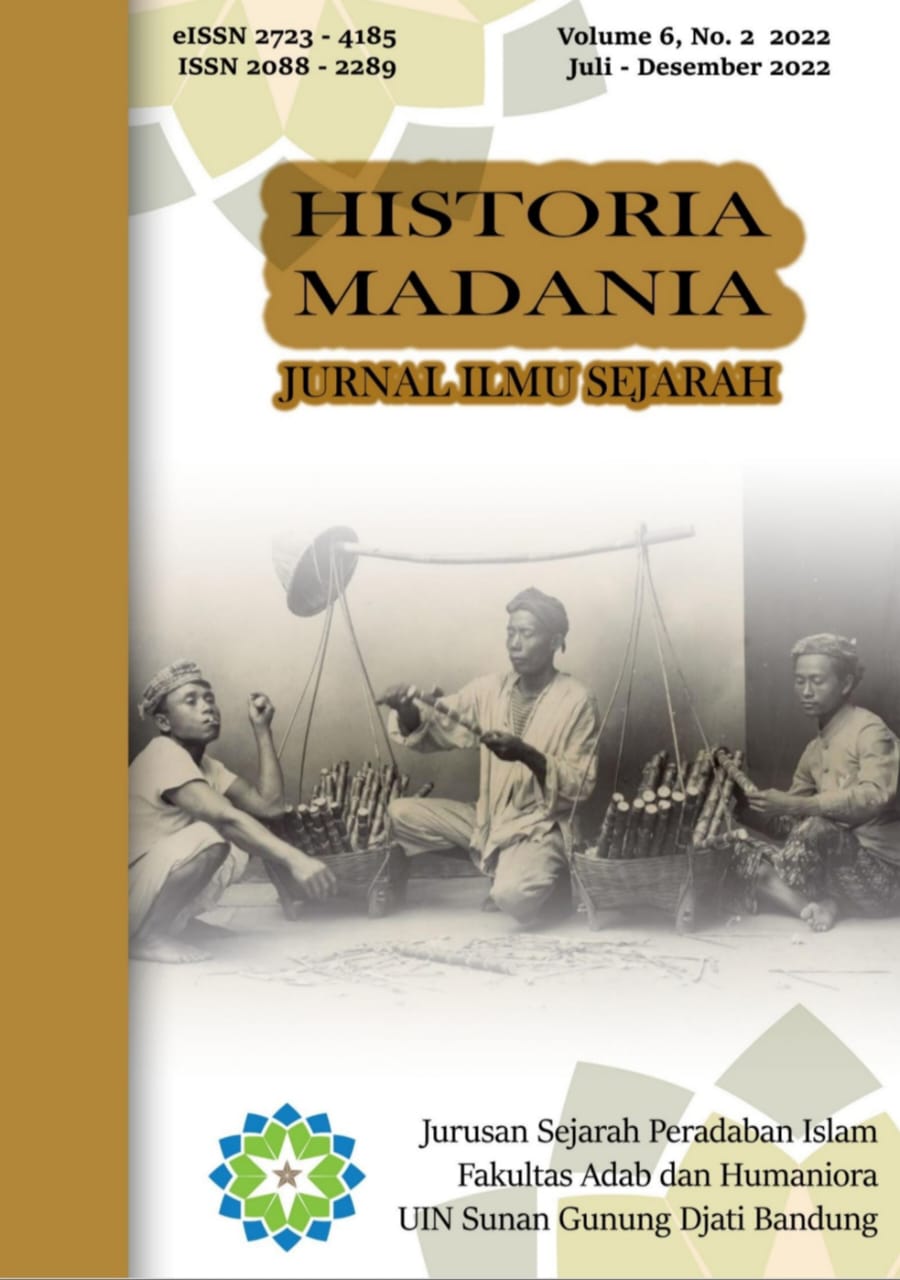Rampogan Macan: Simbolisme Perlawanan terhadap Kolonial dalam Perayaan Hari Besar Islam (1890-1912)
DOI:
https://doi.org/10.15575/hm.v6i2.21046Abstract
This study discusses about Rampogan Macan shows conducted in Blitar in 1890-1912. This show is thought as one of the causes of the extinction of Javanese tiger which still causes a debate among the communities. Based on the further studies of some relevant sources of history, there is a new perspective of symbolism of this show. The first thing comes in mind when hearing about this show is tiger massacre. However this show also has religiosity values and symbols of people’s resistance to colonialism. Symbolizing the tiger as a glorified figure is not applied in this Rampogan Macan show. This is because the main goal of this show is to defeat the tiger which is an enemy representation. This study used historical research method with four stages including heuristic, verification of historical sources, interpretation, and hystorigraphy. The results show: first, the origin of Rampogan Macan in Blitar because the pakoso assigned to share they hold show on their area. Second, rampogan tiger as a form of popular resistance against colonial ruler .Third, the impact of the show is a reduction in population Java tigers.
Keywords: Rampogan Macan Blitar, Symbolism, Islamic CelebrationReferences
Daftar Sumber
Arsip Koran
“De Tijgerplaag in Blitar.†Het Nieuws Van Den Dag Voor Nederlandsch-Indie, 2 Januari 1902.
“De Viering Van Het Eiden Der Poesa in Vroegere Dagen in Kediri.†De Nieuwe Vorstenlanden, 19 Juni 1920.
“Een Dappere Jongen.†Het Nieuws Van Den Dag Voor Nederlandsch-Indie, 19 November 1901.
“Een Rampokpartij.†De Locomotief: Samarangsch Handels-en Advertentie-Blad, 20 Februari 1899.
Ordonantie tot Bescherming van Sommige in het Levende Zoogdieren en Vogels (1909).
“Tijgerplaag in Zuid-Blitar.†Het Nieuws Van Den Dag Voor Nederlandsch-Indie, 19 April 1913.
“Tijgers in Kediri.†Het Nieuws Van Den Dag Voor Nederlandsch-Indie, 4 Desember 1914.
Perjanjian
Staatsblad van Nederlandsch-Indie. Artikel 29 Der Wet Van 23 Mei 1899 (1899).
———. Natuurmonumenten (Bescherming Van De Natuurrijkdommen Van Nederlandsch-Indie), Pub. L. No. 78 (1916).
Buku
Dymond, David. Penulisan Sejarah Lokal: Sebuah Pedoman Praktis. Diterjemahkan oleh Nana Nurlina Soeyono. Direktorat Nilai sejarah, Direktorat Jenderal Sejarah dan Purbakala, dan Direktorat Kebudayaan dan Pariwisata, 2006.
Houben, Vincent J.H. Keraton dan Kompeni: Surakarta dan Yogyakarta 1830-1870. Diterjemahkan oleh E. Setiyawan Alkhatab. Yogyakarta: Benteng Budaya dan Yayasan Adikarya IKAPI, 2002.
Hatta, Mohammad. Untuk Negeriku. Jakarta: Kompas, 2011.
Kartawibawa, R. “Bakda Mawi Rampog.†Jakarta: Balai Pustaka, 1923.
Kuntowijoyo. Pengantar Ilmu Sejarah. Yogyakarta: Tiara Wacana, 2013.
Kusumasumantri, Pandji Yudistira. Sejarah 5 Taman Nasional Pertama, 2016.
Raffles, Thomas Stamford. “The History of Java.†diterjemahkan oleh Eko Prasetoningrum, Nuryati Agustin, dan Idda Qoryati Mahbubah. Yogyakarta: Narasi, 2008.
Ricklefs, Merle Celvin. Yogyakarta di Bawah Sultan Mangkubumi 1749-1792. Diterjemahkan oleh Hartono Hadikusumo dan E. setiawan Alkhatab. Yogyakarta: Matabangsa, 2002.
Setiabudi, Hery. Rampogan Macan: Tragedi Harimau Jawa di Zaman Kolonial. Blitar: Dinas Perpustakaan dan Kearsipan Daerah Kota Blitra, 2018.
Soeratman, Darsiti. Kehidupan Dunia Kraton Surakarta 1830-1939. Yogyakarta: Tamansiswa, 1999.
Artikel Jurnal
Amiluhur, Dihan. Kolonialisme Gladiator Jawa: Sima Maesa dan Rampok Macan di Jawa Abad ke-19. Temanggung: Kendi, 2021.
Boomgard, Peter. “Death to The Tiger! The Development of Tiger and Leopard Rituals in Java, 1605-1906.†South East Asia Research (SOAS), no. Februari 1993 (1994): 141–75.
Budaarsa, K, dan K M Budiasa. “Jenis Hewan Upakara dan Upaya Pelestariannya.†In Disampaikan pada Seminar Hewan Upakara-Fapet Unud, 1–16, 2013. https://repositori.unud.ac.id/protected/storage/upload/repositori/ID3_19581204198503100211081408838makalahjenis-hewan-upakara-pdf.pdf.
Hanifah, Muna Roidatul, dan Hendra Afiyanto. “Perjuangan Mencari Ruang: Jedoran, Media Islamisasi, Dan Peminggiran Kesenian Islam Tulungagung 1970-198.†Al-Isnad 2 (2021). http://ejournal.iainsurakarta.ac.id/index.php/al-isnad/article/view/4906/1572.
Murtadhi, Muhammad Rosyid Ammar, dan Sri Mastuti Purwaningsih. “Rampogan Macan Di Kediri Tahun 1890-1925.†AVATARA, e-Journal Pendidikan Sejarah 6, no. 2 (2018): 307–16. https://jurnalmahasiswa.unesa.ac.id/index.php/avatara/article/view/24637.
Tsuroya, Fatia Inast. “Kritik Etos, Pandangan Dunia, Dan Simbol-Simbol Sakral Terhadap Pandangan Clifford Geertz.†Historis: Jurnal Kajian, Penelitian dan Pengembangan Pendidikan Sejarah 5, no. 2 (2020): 187–91. http://journal.ummat.ac.id/index.php/historis/article/view/3606.
Wessing, Robert. “A Tiger In The Heart: The Javanese Rampok Macan.†Bijdragen tot de Taal-, Land- en Volkenkunde 148 2 (1992): 287–308.
Zulaicha, Lilik. Metodologi sejarah. Surabaya: Digital Library UIN Sunan Ampel, 2014.
Sumber Gambar
“Poster Rampogan Macan,†2012. https://luk.staff.ugm.ac.id/itd/buku/bmr/kaos.html.
Downloads
Published
How to Cite
Issue
Section
Citation Check
License
Authors who publish with this journal agree to the following terms:
- Authors retain copyright and grant the journal right of first publication with the work simultaneously licensed under a Creative Commons Attribution License that allows others to share the work with an acknowledgment of the work's authorship and initial publication in this journal.
- Authors are able to enter into separate, additional contractual arrangements for the non-exclusive distribution of the journal's published version of the work (e.g., post it to an institutional repository or publish it in a book), with an acknowledgment of its initial publication in this journal.
- Authors are permitted and encouraged to post their work online (e.g., in institutional repositories or on their website) prior to and during the submission process, as it can lead to productive exchanges, as well as earlier and greater citation of published work (See The Effect of Open Access).


